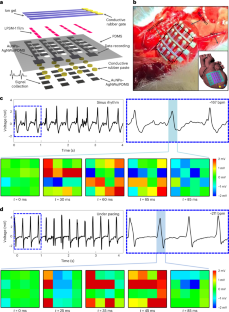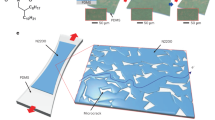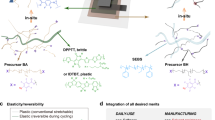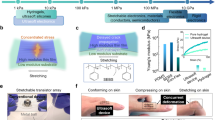Abstract
The development of soft electronics that can be seamlessly integrated with biological tissue requires intrinsically stretchable rubbery semiconductors with high carrier mobilities. However, the scalable fabrication of rubbery semiconductors remains challenging, particularly using methods that are simple and reproducible. Here we report rubbery semiconductor thin films that are based on a lateral-phase-separation-induced micromesh. A two-polymer blend solution is spin coated on a substrate and forms micromesh morphologies via lateral phase separation, consisting of a continuous organic semiconductor-rich phase and an isolated elastomer-rich phase. The micromesh-structured rubbery semiconductors simultaneously provide efficient charge transport and mechanical stretchability, and by using different polymer blends, we create both p-type and n-type rubbery semiconductor films. The films are used to construct rubbery transistors, complementary inverters and bilayer heterojunction photodetectors that can function even under applied strains of up to 50%. We also create an electronic patch that has a transistor active matrix fully made of rubbery materials and can be used to map the biopotentials of a rat heart.
This is a preview of subscription content, access via your institution
Access options
Access Nature and 54 other Nature Portfolio journals
Get Nature+, our best-value online-access subscription
$29.99 / 30 days
cancel any time
Subscribe to this journal
Receive 12 digital issues and online access to articles
$119.00 per year
only $9.92 per issue
Buy this article
- Purchase on Springer Link
- Instant access to full article PDF
Prices may be subject to local taxes which are calculated during checkout






Similar content being viewed by others
Data availability
The data that support the plots within this paper and other findings of this study are available from the corresponding author upon reasonable request.
Change history
11 January 2023
A Correction to this paper has been published: https://doi.org/10.1038/s41928-023-00915-1
References
Chortos, A., Liu, J. & Bao, Z. Pursuing prosthetic electronic skin. Nat. Mater. 15, 937–950 (2016).
Sim, K., Rao, Z., Ershad, F. & Yu, C. Rubbery electronics fully made of stretchable elastomeric electronic materials. Adv. Mater. 32, 1902417 (2020).
Zheng, Y.-Q. et al. Monolithic optical microlithography of high-density elastic circuits. Science 373, 88–94 (2021).
Zhao, X. et al. Soft materials by design: unconventional polymer networks give extreme properties. Chem. Rev. 121, 4309–4372 (2021).
Yuk, H. et al. Dry double-sided tape for adhesion of wet tissues and devices. Nature 575, 169–174 (2019).
Sim, K. et al. An epicardial bioelectronic patch made from soft rubbery materials and capable of spatiotemporal mapping of electrophysiological activity. Nat. Electron. 3, 775–784 (2020).
Oh, J. Y. et al. Intrinsically stretchable and healable semiconducting polymer for organic transistors. Nature 539, 411–415 (2016).
Sim, K. et al. Fully rubbery integrated electronics from high effective mobility intrinsically stretchable semiconductors. Sci. Adv. 5, eaav5749 (2019).
Guan, Y.-S. et al. Air/water interfacial assembled rubbery semiconducting nanofilm for fully rubbery integrated electronics. Sci. Adv. 6, eabb3656 (2020).
Wang, S. et al. Skin electronics from scalable fabrication of an intrinsically stretchable transistor array. Nature 555, 83–88 (2018).
Lee, Y. et al. Deformable organic nanowire field-effect transistors. Adv. Mater. 30, 1704401 (2018).
Lipomi, D. J., Tee, B. C.-K., Vosgueritchian, M. & Bao, Z. Stretchable organic solar cells. Adv. Mater. 23, 1771–1775 (2011).
Kaltenbrunner, M. et al. Ultrathin and lightweight organic solar cells with high flexibility. Nat. Commun. 3, 770 (2012).
Zhang, Z. et al. Kirigami-inspired stretchable conjugated electronics. Adv. Electron. Mater. 6, 1900929 (2020).
Zheng, Y. et al. A molecular design approach towards elastic and multifunctional polymer electronics. Nat. Commun. 12, 5701 (2021).
Choi, D. et al. Elastomer–polymer semiconductor blends for high-performance stretchable charge transport networks. Chem. Mater. 28, 1196–1204 (2016).
Song, E. et al. Stretchable and transparent organic semiconducting thin film with conjugated polymer nanowires embedded in an elastomeric matrix. Adv. Electron. Mater. 2, 1500250 (2016).
Xu, J. et al. Highly stretchable polymer semiconductor films through the nanoconfinement effect. Science 355, 59–64 (2017).
Xu, J. et al. Multi-scale ordering in highly stretchable polymer semiconducting films. Nat. Mater. 18, 594–601 (2019).
Guan, Y.-S., Zhang, Z., Tang, Y., Yin, J. & Ren, S. Kirigami-inspired nanoconfined polymer conducting nanosheets with 2,000% stretchability. Adv. Mater. 30, 1706390 (2018).
Shin, M. et al. Polythiophene nanofibril bundles surface-embedded in elastomer: a route to a highly stretchable active channel layer. Adv. Mater. 27, 1255–1261 (2015).
Kim, H.-J., Sim, K., Thukral, A. & Yu, C. Rubbery electronics and sensors from intrinsically stretchable elastomeric composites of semiconductors and conductors. Sci. Adv. 3, e1701114 (2017).
He, J. et al. Crystallization-arrested viscoelastic phase separation in semiconducting polymer gels. ACS Appl. Polym. Mater. 1, 500–508 (2019).
Zhu, J., Lu, X., Balieu, R. & Kringos, N. Modelling and numerical simulation of phase separation in polymer modified bitumen by phase-field method. Mater. Des. 107, 322–332 (2016).
Dalnoki-Veress, K., Forrest, J. A., Stevens, J. R. & Dutcher, J. R. Phase separation morphology of spin-coated polymer blend thin films. Phys. A: Stat. Mech. Appl. 239, 87–94 (1997).
Dalnoki-Veress, K., Forrest, J. A. & Dutcher, J. R. Mechanical confinement effects on the phase separation morphology of polymer blend thin films. Phys. Rev. E 57, 5811–5817 (1998).
Karim, A. et al. Phase-separation-induced surface patterns in thin polymer blend films. Macromolecules 31, 857–862 (1998).
Chung, H.-J., Ohno, K., Fukuda, T. & Composto, R. J. Internal phase separation drives dewetting in polymer blend and nanocomposite films. Macromolecules 40, 384–388 (2007).
Jo, G., Jung, J. & Chang, M. Controlled self-assembly of conjugated polymers via a solvent vapor pre-treatment for use in organic field-effect transistors. Polymers 11, 332 (2019).
Stinner, F. S. et al. Flexible, high-speed CdSe nanocrystal integrated circuits. Nano Lett. 15, 7155–7160 (2015).
Yoo, H. et al. Reconfigurable complementary logic circuits with ambipolar organic transistors. Sci. Rep. 6, 35585 (2016).
Lei, T. et al. Low-voltage high-performance flexible digital and analog circuits based on ultrahigh-purity semiconducting carbon nanotubes. Nat. Commun. 10, 2161 (2019).
Yan, C. et al. An intrinsically stretchable nanowire photodetector with a fully embedded structure. Adv. Mater. 26, 943–950 (2014).
Li, Q., Guo, Y. & Liu, Y. Exploration of near-infrared organic photodetectors. Chem. Mater. 31, 6359–6379 (2019).
Yang, D. & Ma, D. Development of organic semiconductor photodetectors: from mechanism to applications. Adv. Opt. Mater. 7, 1800522 (2019).
Efstratiadis, G., Sarigianni, M. & Gougourelas, I. Hypomagnesemia and cardiovascular system. Hippokratia 10, 147–152 (2006).
Baid. H., Creed, F. & Hargreaves, J. Oxford Handbook of Critical Care Nursing (Oxford Univ. Press, 2016).
Mellor, G. J. & Behr, E. R. Cardiac channelopathies: diagnosis and contemporary management. Heart 107, 1092–1099 (2021).
Sánchez-Quintana, D., Doblado-Calatrava, M., Cabrera, J. A., Macías, Y. & Saremi, F. Anatomical basis for the cardiac interventional electrophysiologist. BioMed Res. Int. 2015, 547364 (2015).
Reis, L. A., Chiu, L. L. Y., Feric, N., Fu, L. & Radisic, M. Biomaterials in myocardial tissue engineering. J. Tissue Eng. Regen. Med. 10, 11–28 (2016).
Dixon, A. M. R., Allstot, E. G., Gangopadhyay, D. & Allstot, D. J. Compressed sensing system considerations for ECG and EMG wireless biosensors. IEEE Trans. Biomed. Circuits Syst. 6, 156–166 (2012).
Gargiulo, S. et al. PET/CT imaging in mouse models of myocardial ischemia. J. Biomed. Biotechnol. 2012, 541872 (2012).
Xu, L. et al. 3D multifunctional integumentary membranes for spatiotemporal cardiac measurements and stimulation across the entire epicardium. Nat. Commun. 5, 3329 (2014).
Sim, K. et al. Metal oxide semiconductor nanomembrane–based soft unnoticeable multifunctional electronics for wearable human-machine interfaces. Sci. Adv. 5, eaav9653 (2019).
Preston, D. J. et al. A soft ring oscillator. Sci. Robot. 4, eaaw5496 (2019).
Acknowledgements
C.Y. would like to acknowledge the National Science Foundation grants of CAREER (1554499), EFRI (1935291) and CPS (1931893); National Institute Health grant (R21EB026175); and the Office of Naval Research grant (N00014-18-1-2338) under the Young Investigator Program.
Author information
Authors and Affiliations
Contributions
Y.-S.G. and C.Y. conceived the concept and designed the work. Y.-S.G., F.E., Z.R., Z.K., E.C.C., Q.X., Y.L. and X.W. performed the experiment. Y.-S.G., F.E. and E.C.C. analysed the experimental data. Y.-S.G., F.E. and C.Y. wrote the manuscript. All the authors commented and revised the manuscript.
Corresponding author
Ethics declarations
Competing interests
The authors declare no competing interests.
Peer review
Peer review information
Nature Electronics thanks Yun-Hi Kim, Longzhen Qiu and Xuanhe Zhao for their contribution to the peer review of this work.
Additional information
Publisher’s note Springer Nature remains neutral with regard to jurisdictional claims in published maps and institutional affiliations.
Supplementary information
Supplementary Information
Supplementary Notes 1–3, Figs. 1–25 and Tables 1–3.
Supplementary Video 1
Heat maps at 5 ms increments to better illustrate the cardiac action potential propagation over time (sinus rhythm).
Supplementary Video 2
Heat maps at 5 ms increments to better illustrate the cardiac action potential propagation over time (under pacing).
Rights and permissions
Springer Nature or its licensor (e.g. a society or other partner) holds exclusive rights to this article under a publishing agreement with the author(s) or other rightsholder(s); author self-archiving of the accepted manuscript version of this article is solely governed by the terms of such publishing agreement and applicable law.
About this article
Cite this article
Guan, YS., Ershad, F., Rao, Z. et al. Elastic electronics based on micromesh-structured rubbery semiconductor films. Nat Electron 5, 881–892 (2022). https://doi.org/10.1038/s41928-022-00874-z
Received:
Accepted:
Published:
Issue Date:
DOI: https://doi.org/10.1038/s41928-022-00874-z
This article is cited by
-
Phase-separated stretchable conductive nanocomposite to reduce contact resistance of skin electronics
Scientific Reports (2024)
-
A three-dimensional liquid diode for soft, integrated permeable electronics
Nature (2024)
-
Strain-insensitive viscoelastic perovskite film for intrinsically stretchable neuromorphic vision-adaptive transistors
Nature Communications (2024)
-
Achieving tissue-level softness on stretchable electronics through a generalizable soft interlayer design
Nature Communications (2023)
-
Strain-enhanced electrical performance in stretchable semiconducting polymers
npj Flexible Electronics (2023)



